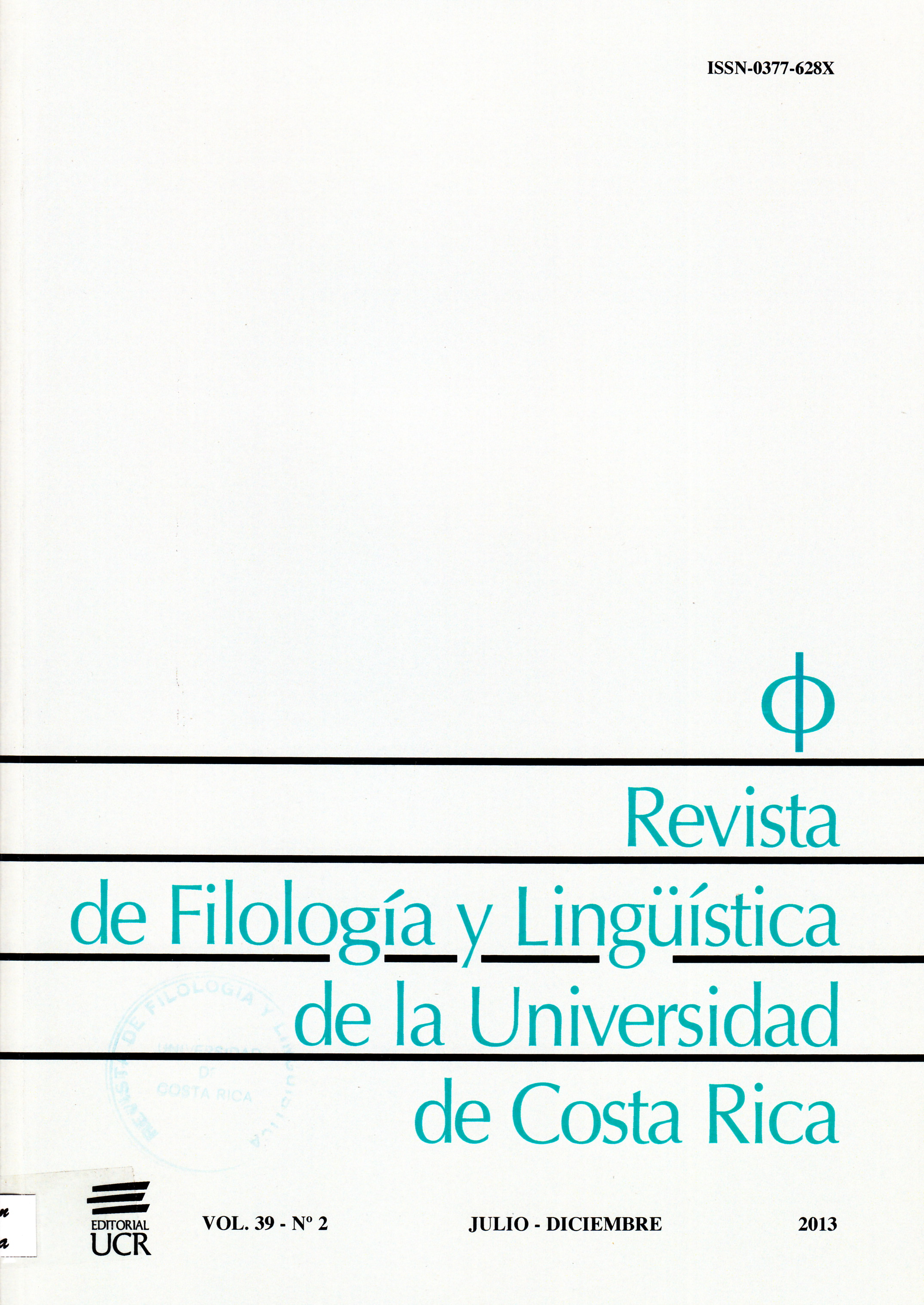Abstract
The present article presents the deviant phonological and morphosyntactic features of the Spanish of a chinese immigrant, establishes the percentages of incidence of such features, and analyzes, from the standpoint of Schumann’s Pidginization Hypothesis, the degree of linguistic simplification observed in the immigrant’s idiolect.References
Allende, Laborde, Vásquez y Frambes-Buxeda (Eds.). 1991. Claves psicológicas en nuestra America. San Juan, Puerto Rico: Homines.
Angulo, H. 2011. El español como segunda lengua de inmigrantes de origen chino en Costa Rica: Un análisis a partir del Modelo de aculturación. Tesis de maestría: Universidad de Costa Rica.
Bermúdez, Q. 2000. El Contexto Internacional de la Inmigración China a Costa Rica. Tesis de Maestría: Universidad de Costa Rica.
Brown, D. 2000. Principles of Language Learning and Teaching. San Francisco: Longman.
Cenoz, J. y J. Perales. 2000. “Las variables contextuales y el efecto de la instrucción en la adquisición de segundas lenguas”. En: Muñoz (Ed.). Segundas Lenguas: Adquisición en el Aula. Barcelona: Ariel. 109-125.
Chen Apuy, H. 1992. “La Minoría China en Costa Rica”. Reflexiones. 5 (1). 1996. “Diversidad en Beijing”. Cuarta Conferencia Mundial de las Naciones Unidas sobre la Mujer. Instituto Interamericano de Derechos Humanos.
Chinen, K. y R. Tucker. 2005. “Heritage Language Development: Understanding the Roles of Ethnic Identity and Saturday School Participation”. Heritage Language Journal. www.isop.ucla.edu/languages/heritagelanguages/journal/article.asp?parentid=28742
Chou, D. 2002. “Los chinos en Hispanoamérica”. Cuaderno de Ciencias Sociales. San José: Facultad Latinoamericana de Ciencias Sociales (FLACSO).
Clements, J. 2003. “On Classifying Language-Contact Varieties”. En: Sayahi (Ed.). Selected Proceedings of the First Workshop on Spanish Sociolinguistics. Somerville, MA: Cascadilla. 1-10. Proceedings Project. www.lingref.com (Documento #1002).
Figueroa, J. 2008. “Aproximación al estudio del español chino hablado en Cuba”. Revista Internacional de Lingüística Iberoamericana. 1 (11): 185-204.
Hu, H-P. 2007. “Natural Second Language Acquisition or Pidginization? Present Tense Verb Usage by Adult Chinese Speakers of Spanish in Guayaquil, Ecuador”. En: Holmquist, Lorenzino y Sayahi (Eds.). Selected Proceedings of the Third Workshop on Spanish Sociolinguistics. 140-149. Somerville, MA: Cascadilla Proceedings Project. www. lingref.com (Documento #1535).
Krashen, S. 1987. Principles and Practice in Second Language Acquisition. Londres: Prentice-Hall International.
Larrinaga, J. y L. Peluso. 1996. Una Aproximación al Español-como L2-hablado por sordos profundos. Universidad de la República.
Lee, V. 1975. Old Lives for New: An Ethnographic Change/Adaptation Study on the Chino Population in Cañas, Guanacaste. Field Research Program: Associated Colleges of the Midwest.
Loría, M. & A. Rodríguez. 2001. “La inmigración china a Costa Rica (1870-1910)”. Revista de Historia. 44: 159-192.
Marín, G. 1991. “La aculturación del latino en Estados Unidos: Una exploración socio-psicológica”. En: Allende et al., 15-27.
Mitchell, Rosamond y F. Myles. 1998. Second Language Learning Theories. Gran Bretaña: Arnold.
Mühlhäusler, P. 1986. Pidgin and Kreole Linguistics. New York: Basil Blackwell.
Romero, F. 2001. “Factores que provocaron las migraciones de chinos, japoneses y coreanos hacia México: siglos XIX y XX: Estudio Comparativo”. Revista de Ciencias Sociales. (90-91): 141-153.
Schumann, J. 1978. “The Acculturation Model for Second Language Acquisition”. En: R. Gingras (Ed.). Second Language Acquisition and Foreign Language Teaching. Arlington, VA: Center for Applied Linguistics. 27-50. 1995. “Second Language Acquisition: The Pidginization Hypothesis”. En: Brown & Gonzo (Eds.). Readings on Second Language Acquisition. New Jersey: Prentice Hall Regents. 262-280.
Smith, D.M. 1972. “Some Implications for the Social Status of Pidgin Languages”. En: Smith y Shuy (Eds.), 47-56.
Smith, D.M. y R.Shuy (Eds.). 1972. Sociolinguistics in Cross-Cultural Analyses. Washington D.C.: Georgetown University Press.
Tong, Virginia. 2000. “The Relationship Between First and Second Languages and Culture: Finding a Cross-cultural Identity”. http://www.behavioradvisor.com/TongLilly.html.
Toro, A. 2010. “Cuando China domine al mundo”. http://www.eluniversal.com/2010/07/22/opi_art_cuando-china-domine_1977470.shtml.

